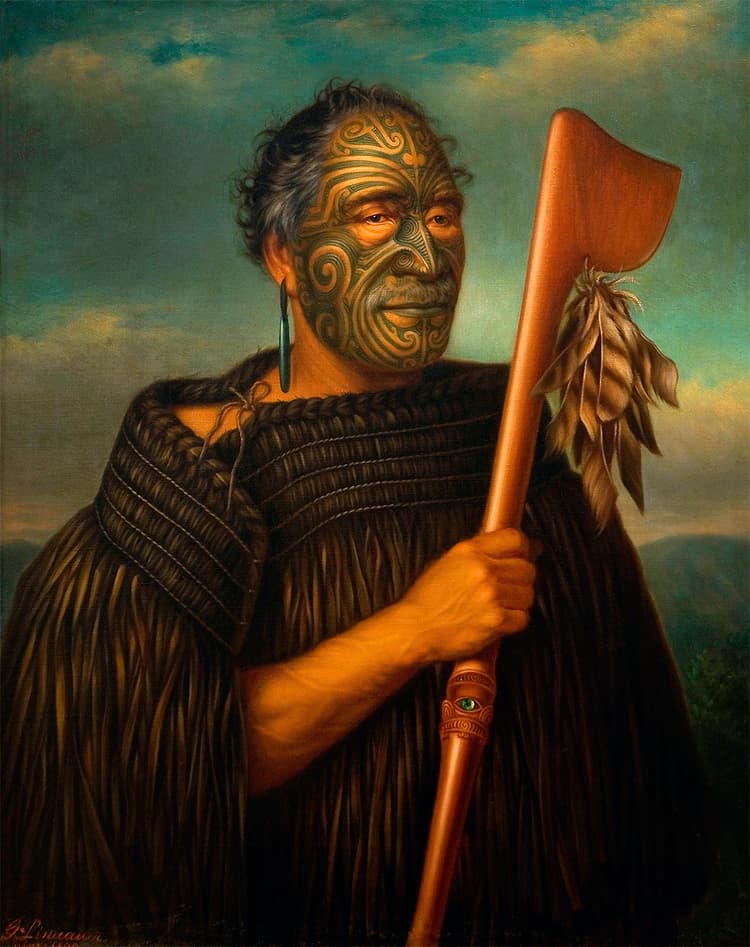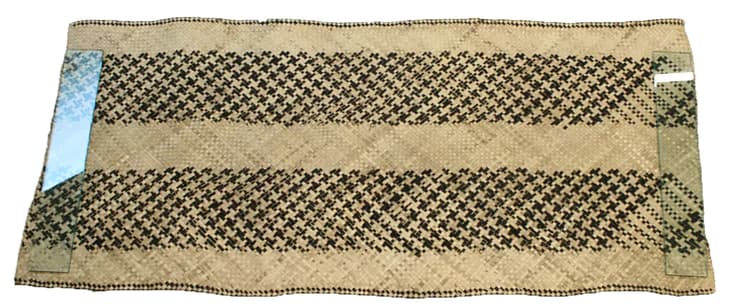Interactions Within and Across Cultures in Pacific Art
Joseph Brown
8 min read
Listen to this study note
Study Guide Overview
This AP Art History study guide covers Pacific Island art, focusing on cultural exchange, spiritual practices, and adaptation. Key examples include the Staff God, Buk Mask, Tamati Waka Nene, Navigation Chart, and Presentation of Fijian Mats and Tapa Cloths to Queen Elizabeth II. The guide explores the function, symbolism, materials, and cultural significance of these artifacts, emphasizing their historical context and roles in cultural exchange. It also includes practice questions and exam tips.
#AP Art History: Pacific Islands Study Guide 🏝️
Welcome! This guide is designed to help you confidently tackle the Pacific Islands section of the AP Art History exam. Let's dive in!
#1. Introduction to Pacific Island Art and Culture
The Pacific Islands are a diverse region with a rich cultural heritage shaped by centuries of interaction. Art and artifacts provide crucial insights into beliefs, values, and traditions. Key themes include cultural exchange, spiritual practices, and adaptation. This section is a on the exam!
#1.1. Overview of Key Examples
- We'll explore the Staff God, Buk Mask, Tamati Waka Nene, Navigation Chart, and the Presentation of Fijian Mats and Tapa Cloths to Queen Elizabeth II.
- These examples highlight the dynamic interactions between different cultures in the Pacific Islands and their impact on cultural heritage.
#2. Religious and Spiritual Artifacts
#2.1. Staff God
Think of the Staff God as a 'spiritual power stick' - it's all about connecting with deities!

Staff-god in its barkcloth wrapping, late 18th–early 19th century, wood, paper mulberry bark, feather, 396 cm, Rarotonga, Cook Islands (© Trustees of the British Museum)
- Function: Religious artifact representing a deity or spirit.
- Symbolism: Symbol of spiritual power.
- Materials: Carved wood adorned with feathers, shells, and natural materials.
- Ritual Use: Used in religious ceremonies to communicate with gods, seek protection, or blessings.
- Cultural Significance: Reflects cultural beliefs, spiritual practices, and artistic traditions.
- Gender Representation: Often represents male deities, symbolizing masculinity and power.
#2.2. Buk (Mask)
Buk masks are like 'cultural storytellers' from the Torres Strait, blending indigenous and colonial influences.

Mask (Buk), Torres Strait, Mabuiag Island, mid to late 19th century,turtle shell, wood, cassowary feathers, fiber, resin, shell, paint, 21 1/2 inches high (The Metropolitan Museum of Art)
- Origin: Torres Strait Islands, between Australia and Papua New Guinea.
- Cultural Blend: Reflects indigenous and colonial influences.
- Design: Intricate designs with local flora, fauna, and cultural motifs.
- Ceremonial Use: Used in dances, ceremonies, storytelling, and spiritual communication.
- Materials: Wood, shell, and pearl inlays.
- Significance: Provides insight into the cultural, spiritual, and historical context of the Torres Strait Islands.
#3. Cultural and Historical Figures
#3.1. Tamati Waka Nene
Remember Tamati Waka Nene as the 'peaceful warrior' who bridged Maori and European worlds.

Gottfried Lindauer, Tamati Waka Nene, 1890, oil on canvas, 101.9 x 84.2 cm (Auckland Art Gallery)
- Identity: Maori warrior and chief from New Zealand in the early 19th century.
- Role: Worked to establish peaceful relations between Maori and European settlers.
- Artistic Depictions: Represented in paintings, carvings, and sculptures.
- Symbolism: Depicted as a strong and proud warrior, with symbols of rank and status.
- Cultural Influences: Artworks reflect Maori, European, and Pacific Island artistic traditions.
- Historical Context: Provides insight into the cultural, political, and historical context of New Zealand during the early 19th century.
#4. Navigational and Cultural Exchange
#4.1. Navigation Chart
Focus on how navigation charts were not just maps, but also cultural and mythological records.

Navigation chart (rebbelib), probably 19th century C.E., wood, shell, 67.5 x 99 x 3 cm, Marshall Islands, Micronesia © Trustees of the British Museum
- Use: Used by Pacific Island peoples to navigate the Pacific Ocean.
- Materials: Created on cloth, bark, or other materials.
- Design: Decorated with intricate designs and symbols.
- Mythological Elements: Incorporated local mythology and cosmology.
- Cultural Significance: Facilitated exploration, trade, and cultural exchange.
- Knowledge Transmission: Served as a tool for maintaining and transmitting cultural knowledge.
#4.2. Presentation of Fijian Mats and Tapa Cloths to Queen Elizabeth II
Don't confuse the presentation with just the objects themselves. The event is a key example of cultural exchange!

Presentation of Fijian mats and tapa cloths to Queen Elizabeth II during the 1953–54 royal tour, silver gelatin print, 16.5 x 22 cm (Alexander Turnbull Library, Wellington, New Zealand)

Mat, Fiji, date unknown, pandanus leaf, 176.5 x 77.5 cm (Auckland War Memorial Museum)
- Event: Cultural exchange between the Fijian people and the British royal family.
- Objects: Mats and tapa cloths, traditional woven textiles created by Fijian women.
- Purpose: Showcased Fijian cultural practices and established a connection with the British royal family.
- Cultural Significance: Demonstrates the importance of cultural exchange and the role of traditional textiles in Fijian culture.
- Impact: Promoted understanding and cooperation between different cultural groups.
#5. Final Exam Focus
Key Topics: Cultural exchange, spiritual practices, symbolism, materials, and historical context. Be ready to compare and contrast different art forms and their functions.
#5.1. Common Question Types
- Multiple Choice: Expect questions on identifying artworks, their functions, and cultural significance.
- Short Answer: Be prepared to discuss the historical context and cultural impact of the artworks.
- Free Response: Analyze how these artworks reflect cultural interactions and beliefs.
#5.2. Last-Minute Tips
- Time Management: Pace yourself and don't spend too long on any one question.
- Avoid Common Pitfalls: Don't just describe, analyze! Connect artworks to their cultural and historical context.
- Strategies: Use keywords and specific examples to support your answers. Practice explaining the significance of these works to a friend – if you can explain it, you know it!
#6. Practice Questions
Practice Question
Multiple Choice Questions:
-
Which of the following best describes the primary function of the Staff God? a) A navigational tool b) A symbol of spiritual power c) A depiction of a historical figure d) A form of currency
-
What is a key characteristic of Buk masks from the Torres Strait? a) They are primarily made of gold. b) They feature intricate designs inspired by local flora and fauna. c) They are used for everyday wear. d) They are solely used for trade.
-
The presentation of Fijian mats and tapa cloths to Queen Elizabeth II is an example of: a) A purely economic exchange b) A demonstration of military strength c) A significant cultural exchange d) A routine diplomatic procedure
Free Response Question:
Analyze how the Staff God and the Buk mask reflect the spiritual and cultural beliefs of their respective societies. In your response, consider the materials used, the symbolism employed, and the intended functions of these objects. (10 points)
Scoring Breakdown:
- Identification (2 points): Correctly identify the Staff God and Buk mask and their respective cultures.
- Materials and Symbolism (4 points): Discuss the materials used in each object and their symbolic meaning within their cultures.
- Functions (2 points): Explain the intended functions of each object in their respective societies.
- Analysis and Comparison (2 points): Analyze how these objects reflect the spiritual and cultural beliefs of their societies and compare their approaches.
Good luck! You've got this! 💪
Continue your learning journey

How are we doing?
Give us your feedback and let us know how we can improve





